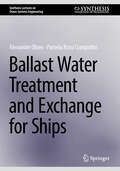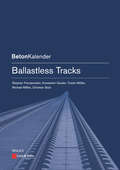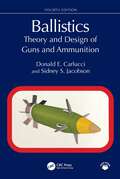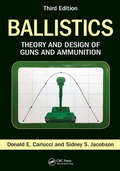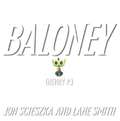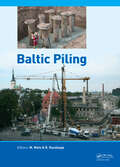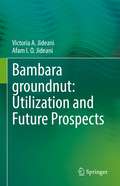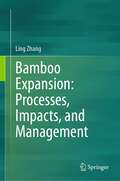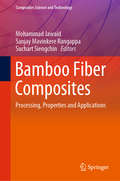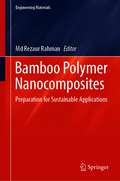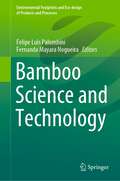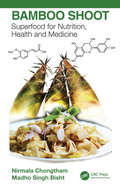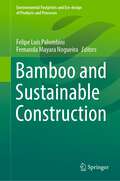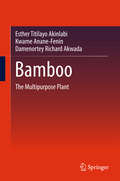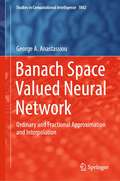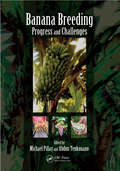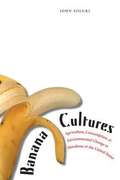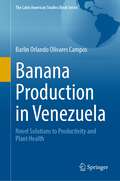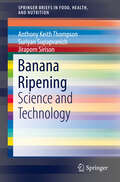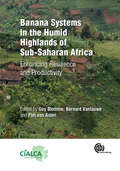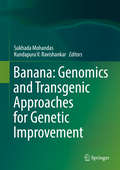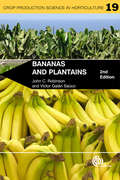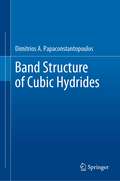- Table View
- List View
Ballast Water Treatment and Exchange for Ships (Synthesis Lectures on Ocean Systems Engineering)
by Alexander Olsen Pamela Rossi CiampoliniThe inadvertent transfer of harmful aquatic organisms and pathogens in the ballast water of ships has been determined to have caused a significant adverse impact to many of the world's coastal regions. The international maritime community, under the auspices of the IMO has developed several documents, including the “International Conventions for the Control and Management of Ship's Ballast Water and Sediments, 2004”, (Ballast Water Management Convention), which are aimed at preventing the introduction of unwanted aquatic organisms and pathogens through the discharge of ballast water and sediments. The Ballast Water Management Convention applies to vessels registered in a country which is party to the Convention and to those vessels registered in other countries when operating in the waters of a country which is party to the Convention. As a means to prevent, minimize and ultimately eliminate the risk to the environment, human health, property and resources arising from the transferof harmful aquatic organisms and pathogens through the control and management of vessel's ballast water and sediment, as well as to avoid unwanted side-effects from that control, the Convention requires vessels to conduct a ballast water exchange or be fitted with an approved ballast water management system. It is noted that several studies have shown that the effectiveness of ballast water exchange varies and is dependent on the vessel type (design), exchange method (sequential, flow-through and dilution methods), ballasting system configuration, exchange location, weather conditions and vessel's trading pattern. For these reasons (and others), it has been determined that ballast water exchange does not provide adequate protective measures to prevent damage from organisms and pathogens carried in a vessel's ballast, even though exchange was considered to be acceptable as an interim solution.This book includes updates for the clarification of Survey requirements and adds the definition of biological commissioning, testing as well as requirements for Class approved Service Providers to conduct biological commissioning testing. Moreover, this book includes updates due to the adoption of the requirements from IACS UR M74, Rev. 2 and UR F45 and is applicable for existing ships, where an application for approval for the plans of BWMS is made on or after 1 July 2022; or for new ships contracted for construction on or after 1 July 2022.
Ballastless Tracks (Beton-Kalender Series)
by Stephan Freudenstein Konstantin Geisler Tristan Molter Michael Missler Christian StolzDue to increasing traffic flows the extension of transport infrastructure with rail roads and high speed lines is an ongoing process worldwide. Ballastless track systems with concrete slabs are used more and more. Following the first trials in the 1970s and more than four decades of R&D work on ballastless track, the level of development is such that it can be confirmed that ballastless track is suitable for use as an alternative to ballasted track. This book makes a contribution to the state of the art of ballastless track by describing the basics for designing the ballastless track. Important advice is provided regarding the construction of ballastless track on earthworks and in tunnels. There is also a description of the technical history of the development of ballastless track on bridges and the ensuing findings for bridge design. The state of the art of ballastless track for switches, important information on details concerning drainage, transitions, accessibility for road vehicles and experience gleaned from maintenance round off the work. Selected chapters from the German concrete yearbook are now being published in the new English "Beton-Kalender Series" for the benefit of an international audience. Since it was founded in 1906, the Ernst & Sohn "Beton-Kalender" has been supporting developments in reinforced and prestressed concrete. The aim was to publish a yearbook to reflect progress in "ferro-concrete" structures until - as the book's first editor, Fritz von Emperger (1862-1942), expressed it - the "tempestuous development" in this form of construction came to an end. However, the "Beton-Kalender" quickly became the chosen work of reference for civil and structural engineers, and apart from the years 1945-1950 has been published annually ever since.
Ballistics: Theory and Design of Guns and Ammunition
by Donald E. Carlucci Sidney S. JacobsonBallistics examines the analytical and computational tools for predicting a weapon’s behavior in terms of pressure, stress, and velocity, demonstrating their applications in ammunition and weapons design. It includes updated and revised equations, end-of-chapter problems, case studies, and practical examples.Explaining the physics of a gun launch, the book describes the behavior of the propelling charge that moves the projectile through the gun tube and the necessary methods to calculate how the projectile will fly. The new edition features a new chapter on closed vessel experimentation and analysis, which discusses closed bomb testing to incorporate new propellants into interior ballistics designs. It covers the mathematical fundamentals that are key to developing a safe and reliable gun system.With its thorough coverage of interior, exterior, and terminal ballistics, this new edition continues to be the standard resource for ballistics experts and researchers studying the technology of guns and ammunition and designing state-of-the-art propellants.Instructors will be able to utilize a Solutions Manual and Figure Slides for their course.
Ballistics: Theory and Design of Guns and Ammunition, Third Edition
by Donald E. Carlucci Sidney S. JacobsonWith new chapters, homework problems, case studies, figures, and examples, Ballistics: Theory and Design of Guns and Ammunition, Third Edition encourages superior design and innovative applications in the field of ballistics. It examines the analytical and computational tools for predicting a weapon’s behavior in terms of pressure, stress, and velocity, demonstrating their applications in ammunition and weapons design. New coverage in the Third Edition includes gas-powered guns, and naval ordinance. With its thorough coverage of interior, exterior and terminal ballistics, this new edition continues to be the standard resource for those studying the technology of guns and ammunition.
Baloney (Henry P.)
by Jon ScieszkaThe twisted team that gave the world Squids Will Be Squids and The Stinky Cheese Man now delivers a whole lot of Baloney. <P><P> Henry is an alien schoolkid who needs to come up with one very good excuse to explain why he is late for szkola, again. Otherwise, his teacher Miss Bugscuffle promises, it's Permanent Lifelong Detention. Henry's tall tale of his lost zimulis-received from deep space by Jon Scieszka-is told in at least twenty different Earth languages and graphically recreated in Lane Smith's out-of-this-world illustrations. The unbelievable trip into Henry's wild universe may be the most original excuse ever for being late for szkola. Or it might just be Baloney.
Baltic Piling
by M. Mets R. Raudsepp'Baltic Piling' contains the proceedings of theBaltic Piling Days 2012 (Tallinn, Estonia, 3-5 September 2012). The book includes contributions on current issues in pile foundation engineering:- Interaction of pile and grillage;- Formation of pile bearing capacity- Settlements of piles- Pile foundation under historical buildings- Thermopiles, and
Bambara groundnut: Utilization and Future Prospects
by Victoria A. Jideani Afam I. JideaniThe Bambara groundnut (BGN) or Vigna subterranea is an extremely hardy grain legume. As it produces reasonable yields even under conditions of drought and low soil fertility, it is also a climate-smart crop. Previously underutilized, BGN is the subject of growing interest among researchers and consumers for its balanced nutritional profile. Indigenous consumers of BGN report medicinal benefits from the plant; however, such knowledge is at risk of being lost with the urbanization and changing lifestyles of younger generations. To date, there is no comprehensive resource on the Bambara groundnut, despite market demand for plant proteins around the globe. Authored by scientists who have researched and developed patents using BGN, Bambara Groundnut: Utilization and Future Prospects aims to fill this gap. The text provides in-depth coverage on breeding, food and feed utilization, medicinal benefits and future research prospects. Drawing on both indigenous knowledge and cutting-edge research, Bambara Groundnut is the first book to fully explore the potential of this remarkable crop.
Bamboo Expansion: Processes, Impacts, and Management
by Ling ZhangThis book highlights processes, impacts and management practices of bamboo expansion occurring in areas where it is distributed around the world. Although not conceptually plant invasions, bamboo expansion has been considered an “invasion” based on its characteristics and the impacts it caused on adjacent ecosystems it expanded into, including altered element cycling, transformed soil microbial community compositions, decreased biodiversity, fluctuated primary productions, etc. However, the processes and impacts during or after complete expansion and the underlying mechanisms of successful expansion, are still unclear. The ecological effects of bamboo expansion are not given full consideration and are not thoroughly understood. Based on the latest studies, this book synthesizes research progress of bamboo expansion effects on the soil abiotic environment, soil microbial community compositions, plant characteristics, ecosystem biodiversity, element cycling process, and ecological effects of primary management practice, etc. This book will provide a thorough understanding of ecological changes following bamboo expansions, benefit the effective control of expanding bamboo with respect to decreased biodiversity and mitigation of global change, and accurate prediction and evaluation of bamboo expansion impacts currently and in the future occur around the world. This book presents critical points that need further investigation based on the latest findings, which will be helpful for ecological researchers, policymakers, forestry workers, or graduate and PhD students.
Bamboo Fiber Composites: Processing, Properties and Applications (Composites Science and Technology)
by Mohammad Jawaid Suchart Siengchin Sanjay Mavinkere RangappaThis book summarizes many of the recent developments in the area of bamboo composites with emphasis on new challenges for the synthesis characterization, properties of bamboo composites and practical applications. The book provides an update of all the important areas of (synthesis, processing, properties and application) bamboo fibers and its composites in a comprehensive manner. The chapters contributed by leading researchers from industry, academy, government and private research institutions across the globe benefit academics, researchers, scientists, engineers and students in the field of natural fiber composites.
Bamboo Polymer Nanocomposites: Preparation for Sustainable Applications (Engineering Materials)
by Md Rezaur RahmanThis bookshows how to enhance somebamboopropertiesandthesurface treatmentsforobtaininghigh strength nanocomposites. It describes the tensile, flexural and impact strength, surface behaviour, morphological analysis, infrared spectral functional analysis and thermal properties analysis of manufacture nanocomposites. It also investigates the optimization of fabrication techniquesto prepare bamboo nanocomposites reinforcedwithvarious polymers. The book alsodescribesenvironmental impact analysis of bamboo nanocomposites. This book concludes with the nano-enhancement on bamboo species to produce nanocomposites and possibleusage of nanocomposites materials in terms of sustainability and economics.
Bamboo Science and Technology (Environmental Footprints and Eco-design of Products and Processes)
by Felipe Luis Palombini Fernanda Mayara NogueiraBamboo is one of the most sustainable materials in nature due to its fast growth, rapid regeneration, outstanding mechanical properties, and applications in numerous industries. Latest technological advances have been allowing the plant to be studied and applied to exciting new projects. Being bamboo an icon of sustainable development, this book approaches the latest developments in the study of the plant, either as a natural resource or as a source of inspiration for more efficient designs. With the global urging demand for more sustainable practices, innovations in bamboo science and technology are key to the development of environmentally sound solutions.
Bamboo Shoot: Superfood for Nutrition, Health and Medicine
by Nirmala Chongtham Madho Singh BishtBamboo is an ordinary plant with extraordinary properties. With its high growth rate and self-renewing ability, bamboo’s sustainability is unparalleled. Bamboo is an important resource for a healthy planet, and its shoots hold manifold nutritional benefits. Based on 18 years of research, Bamboo Shoot: Superfood for Nutrition, Health and Medicine details health-promoting bioactive compounds found in bamboo and offers practical guidance on how this vegetable, bamboo shoot, is used for food fortification. Already a delicacy in many Asian countries, bamboo shoots aid in the prevention of cardiovascular disease, cancer, diabetes, hypertension and obesity. Exploring the tradition and culture of bamboo in Asian countries, this book also provides information on the science behind the nutritional value of bamboo shoots. Written by individuals with expertise in bamboo shoot nutrition and fully illustrated in colour, this book reveals the antioxidant activity of bamboo shoots and discusses the potential for bamboo to be used as an ingredient in functional foods and nutraceuticals. This highly practical book discusses processing and packaging of shoots for long term storage and using bamboo in the development of novel food products. Features: Elucidates the nutrients and phytochemicals in over 30 bamboo species and includes a glossary of scientific names Highlights the nutraceutical and antioxidant properties of bamboo Describes novel healthy food products fortified with bamboo shoots and provides food recipes using bamboo Explains how bamboo can help countries achieve their sustainable development goals, from poverty reduction, food security, improved nutrition and prevention of diseases to climate change mitigation and inclusive green economic development Aimed at professionals in the nutrition and food processing industry, this book appeals to those with an interest in incorporating bamboo into a healthier lifestyle. Endorsements This is a unique book interestingly crafted to highlight the important nutritional, health and medicinal aspects of Bamboo, an area that is greatly underexplored. It will bring awareness that bamboo shoots are a low calorie, high fibre nutritious vegetable packed with vitamins and minerals. - Prof. Cherla Sastry, Founding Director General INBAR and Adjunct Professor, University of Toronto, Canada This book brings a series of answers to all questions related to bamboo as a superfood [and will] enlighten readers how to transform bamboo shoots using either traditional or modern techniques, how to package them and how to use them as a functional and nutraceutical food. It also provides a series of cooking recipes for healthy eating while we enjoy our food. - Ximena Londoño, Founder, A Bamboo and Guadua Paradise, Colombia
Bamboo and Sustainable Construction (Environmental Footprints and Eco-design of Products and Processes)
by Felipe Luis Palombini Fernanda Mayara NogueiraBamboo is considered one of the most sustainable and versatile building materials, driving the development of multiple techniques for its study and utilization. With new techniques to better analyze, comprehend, and exploit its uses, the plant can be used in numerous applications. From direct building material to composites, this book explores the latest developments in the application of bamboo in the sustainable construction industry.
Bamboo: The Multipurpose Plant
by Esther Titilayo Akinlabi Kwame Anane-Fenin Damenortey Richard AkwadaThis book is intended for use both in the industry and the academia. It introduces the physical, chemical and the mechanical properties as well as the characterization of bamboo. Novel industrial applications in structural, non-structural, reinforcement, afforestation, land reclamation, environmental significance, textile, medical, geotechnical, hydraulic, food, pulp and the paper industries are addressed in detail. Bamboo has been used for centuries as a structural material as well as in diverse engineering applications, food and medicinal purposes, especially in Asia. As a natural fiber composite, bamboo has the potential for many developments in academic and industrial research. Current literature on composites tends to focus on bamboo as a plant or solely as a structural engineering material. This book seeks to bring together these two extremes and provides a holistic resource on the subject.
Banach Space Valued Neural Network: Ordinary and Fractional Approximation and Interpolation (Studies in Computational Intelligence #1062)
by George A. AnastassiouThis book is about the generalization and modernization of approximation by neural network operators. Functions under approximation and the neural networks are Banach space valued. These are induced by a great variety of activation functions deriving from the arctangent, algebraic, Gudermannian, and generalized symmetric sigmoid functions. Ordinary, fractional, fuzzy, and stochastic approximations are exhibited at the univariate, fractional, and multivariate levels. Iterated-sequential approximations are also covered. The book’s results are expected to find applications in the many areas of applied mathematics, computer science and engineering, especially in artificial intelligence and machine learning. Other possible applications can be in applied sciences like statistics, economics, etc. Therefore, this book is suitable for researchers, graduate students, practitioners, and seminars of the above disciplines, also to be in all science and engineering libraries.
Banana Breeding: Progress and Challenges
by Michael Pillay Abdou TenkouanoWith the current world population growth of 1.2%, the earth can expect to house 9-10 billion people by 2050. Food production, too, must increase to accommodate these numbers. Easy growing, high calorie, nutritious foods, such as bananas are the top priority as a solution to this imminent problem. The first comprehensive compendium on bananas in rec
Banana Cultures
by John SoluriBananas, the most frequently consumed fresh fruit in the United States, have been linked to Miss Chiquita and Carmen Miranda, "banana republics," and Banana Republic clothing stores-everything from exotic kitsch, to Third World dictatorships, to middle-class fashion. But how did the rise in banana consumption in the United States affect the banana-growing regions of Central America? In this lively, interdisciplinary study, John Soluri integrates agroecology, anthropology, political economy, and history to trace the symbiotic growth of the export banana industry in Honduras and the consumer mass market in the United States. Beginning in the 1870s when bananas first appeared in the U. S. marketplace, Soluri examines the tensions between the small-scale growers, who dominated the trade in the early years, and the shippers. He then shows how rising demand led to changes in production that resulted in the formation of major agribusinesses, spawned international migrations, and transformed great swaths of the Honduran environment into monocultures susceptible to plant disease epidemics that in turn changed Central American livelihoods. Soluri also looks at labor practices and workers' lives, changing gender roles on the banana plantations, the effects of pesticides on the Honduran environment and people, and the mass marketing of bananas to consumers in the United States. His multifaceted account of a century of banana production and consumption adds an important chapter to the history of Honduras, as well as to the larger history of globalization and its effects on rural peoples, local economies, and biodiversity.
Banana Production in Venezuela: Novel Solutions to Productivity and Plant Health (The Latin American Studies Book Series)
by Barlin Orlando Olivares CamposThis book presents an important contribution to the knowledge of the banana soils of Venezuela. Banana, the edible fruit of Musaceae, is a staple food for more than 400 million people worldwide due to their nutritional and energy attributes. This makes Musaceae a crop of worldwide relevance, particularly in tropical regions, highlighting the impact of improved Musaceae cropping systems in the current efforts worldwide oriented towards a new agricultural revolution based on sustainable intensification. To achieve this, better practices for food production based on scientific and technical research capable to consider the complexity and variability within the agri-food sector are necessary. The research presented in this book is oriented towards providing answers to the causes of two aspects considered of high relevance for banana production, both affecting productivity and sustainability, always addressed for the Venezuelan conditions, one of the world’s largest producing countries: 1- The impact of phytosanitary risks related to Fusarium Wilt (FW) and the influence of the soil on the incidence of Banana Wilt (BW); and 2- An observed trend towards loss of productivity and decline of soil quality in some commercial farms of Aragua and Trujillo states in Venezuela. The book presents a pioneering study in the application of categorical regression (CATREG) in the characterization of banana soils and analyses soil morphological variables, such as texture, dry consistency, biological activity, reaction to HCl, and type of structure to characterize soil productivity for growing healthy bananas. It develops, for the first time in Venezuela, risk analysis and climatic suitability maps for lethal wilt disease in bananas caused by Fusarium oxysporum f. sp. cubense (Foc) Tropical Race 4 (TR4) (syn. Fusarium odoratissimum). Innovative machine learning techniques are used to predict BW so that future crop development can be done more efficiently and sustainably.
Banana Ripening: Science and Technology (SpringerBriefs in Food, Health, and Nutrition)
by Anthony Keith Thompson Suriyan Supapvanich Jiraporn SirisonThe technology used to ripen bananas is affected by a wide range of factors, including the cultivar, growing conditions, harvesting method, and maturity at which the fruit are harvested and handled. Various post harvest treatments applied to fruit can also impact ripening. While many textbooks have been dedicated to Musa (bananas and plantains), none have focused exclusively on the ripening process. The commercial ripening of bananas and the chemical changes that occur thereby are considered here in detail. In developed, temperate countries where bananas are imported, successful ripening technologies have evolved. Most bananas, however, are marketed locally in the country where they are grown, and often the ripening technologies used have economic and health implications. This brief offers an in-depth discussion of not only the implications of these technologies, but also of alternative ripening methods and their commercial applications. For an understanding of both the chemical basis by which bananas ripen and the technologies used to control the process, look no further than this essential text.
Banana Systems in the Humid Highlands of Sub-Saharan Africa
by Michael Bolton David Turner Guy Blomme Anne Rietveld Nicolas Roux Deo Kantungeko Laurence Jassogne Idd Ramathani William Tinzaara Emily Ouma Svetlana Gaidashova Fenton Beed Muller Kamira Alex Barekye Francois Iradukunda Valentine Nakato Emmanuel Njukwe Piet Van Asten Charles Sivirihauma Faustin Ngama Boloy Edouard Rurangwa Walter Ocimati Bernard Vanlauwe Sam Mpiira Idja Sikyolo Joseph Adheka Alex Rutikanga'Banana Systems in the Humid Highlands of Sub-Saharan Africa: Enhancing Resilience and Productivity' addresses issues related to agricultural intensification in the (sub)humid highland areas of Africa, based on research carried out in the Great Lakes Region by the Consortium for Improving Agriculture-based Livelihoods in Central Africa.
Banana Systems in the Humid Highlands of Sub-Saharan Africa: Enhancing Resilience and Productivity
by Michael Bolton David Turner Anne Rietveld Nicolas Roux Deo Kantungeko Laurence Jassogne Idd Ramathani William Tinzaara Emily Ouma Svetlana Gaidashova Fenton Beed Muller Kamira Alex Barekye Francois Iradukunda Valentine Nakato Emmanuel Njukwe Charles Sivirihauma Faustin Ngama Boloy Edouard Rurangwa Walter Ocimati Sam Mpiira Idja Sikyolo Joseph Adheka Alex Rutikanga‘Banana Systems in the Humid Highlands of Sub-Saharan Africa: Enhancing Resilience and Productivity’ addresses issues related to agricultural intensification in the (sub)humid highland areas of Africa, based on research carried out in the Great Lakes Region by the Consortium for Improving Agriculture-based Livelihoods in Central Africa.
Banana: Genomics and Transgenic Approaches for Genetic Improvement
by Sukhada Mohandas Kundapura V. RavishankarBananas and plantains are among the most important food and cash crops in the world. They are cultivated in more than 135 countries, across the tropics and subtropics, with an annual global production of ca. 130 million metric tonnes. Though bananas are one of the most important components of food security in many developing countries, banana production is threatened by both abiotic and biotic stresses. These include a wide range of diseases and pests, such as bunchy top virus, burrowing nematodes, black Sigatoka or black leaf streak, Fusarium wilt, etc. In recent years, considerable progress has been made and several biotechnological and genomic tools have been employed to help understand and unravel the mysterious banana genome. Molecular and genomic studies have helped to decipher the Musa genome and its evolution. Genetic linkage map and whole genome sequencing of both Musa acuminata and Musa balbisiana (progenitors of cultivated banana) have completely changed the way of thinking and the approach on banana crop improvement. Whole-genome sequencing has helped to improve the selection of quantitative traits such as yield, as well as the selection of optimal parents for developing required hybrids in breeding programs. Gene isolation and the analysis of mutants have helped in the characterization of genes of agronomic value and the associated regulatory sequences. With the advent of molecular markers and new statistical tools, it is now possible to measure the diversity, identify genes and useful alleles linked to important agronomic traits. Further these alleles can be incorporated into cultivars through marker assisted selection or through transgenic approach. Transgenic approaches are potential tools for direct transfer of these genes into popular cultivars, which are generally not amenable for conventional breeding techniques, in specific with crops such as bananas which are sterile, triploid and heterozygous thereby making it difficult to reconstruct the recurrent genotypes in banana. Transgenic techniques thus have helped overcome the difficulty of working with sterile, triploid banana crop. In the last five years, enormous amount of new information and techniques have been generated for banana. A comprehensive book entitled "Banana: Genomics and Transgenic Approaches for Genetic improvement" on banana genomics, latest transgenic technologies and tools available for improved crop development in banana will address all these requirements.
Bananas and Plantains
by John Robinson Víctor Galán SaúcoBananas and plantains are major fruit crops in the tropics and subtropics, making a vital contribution to the economies of many countries. In the last 15 years, substantial changes have occurred in banana production, among them the increased importance of fungal and viral diseases and their serious impact on Cavendish export cultivars, smallholder plantains and cooking bananas. Changes in production systems such as protected greenhouse cultivation, organic, fair-trade and integrated cultivation and their respective certification schemes have also become prominent. This book provides an accessible review of the scientific principles of banana production and how these relate to field practices. Revised and updated with expanded coverage of world trade statistics and policies, breeding of new cultivars in relation to disease resistance and markets, prospects for genetically-modified bananas and the increasing role of endophytes in controlling pests and diseases, this new edition is an essential resource for researchers and students in horticulture.
Bananas and Plantains (2nd edition)
by John C. Robinson Victor Galan SaucoThis book provides an accessible review of the scientific principles of banana production and relates these to field practices. This revised and updated edition includes expanded coverage of world trade, organic and integrated cultivation, and cultivation in greenhouses.
Band Structure of Cubic Hydrides
by Dimitrios A. PapaconstantopoulosThis book compiles detailed results of electronic structure calculations for most possible cubic monohydrides, dihydrides and selected trihydrides related to superconductivity, comprising elements with atomic numbers up to 103. Beginning with an introduction to the theory and details of the computational methods implemented, this handbook presents a collection of chapters containing results for different classes of cubic hydrides, featuring tables of three-centre and two-centre tight-binding parameterizations, diagrams of energy bands, and densities of states with angular momentum decomposition. Equilibrium lattice parameters and bulk moduli are also included, along with the electron-ion matrix element (Hopfield-McMillan parameter), Stoner criterion for ferromagnetism and values of Fermi velocities and plasmon energies. Each chapter features a brief text explaining the results presented with comparison to experimental values when available. A selection of the implemented computer codes is reproduced for the reader’s own use. This handbook is an ideal complement to any standard electronic structure text for students and researchers in materials science, condensed matter physics, and quantum chemistry.
